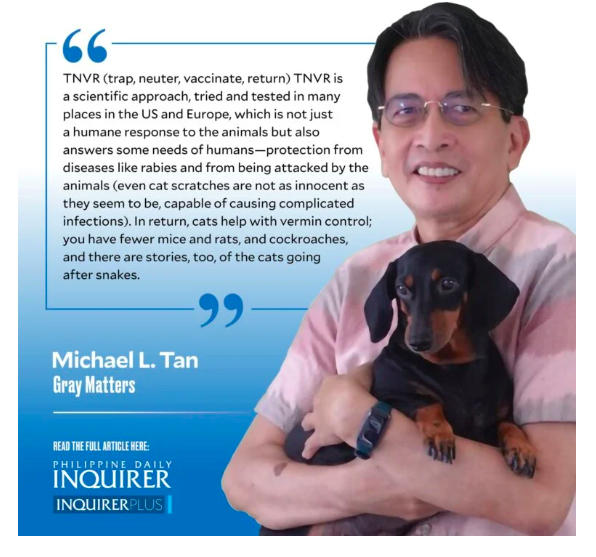Farmers’ cats

It had been a long time since I visited Farmers Market (yes, without an apostrophe). During my most recent visit, right as I entered the market and walked past its fruit stands, I saw a cat sitting calmly on a stool, visibly comfortable with the many people passing by, including several who would pet or stroke her.
As I moved around, I noticed many more of these cats, so very different from your usual stray cats. They clearly did not have specific owners, but they weren’t nervous about people.
In the past, I’d only see occasional cats that seemed to have entered into some kind of social contract with the stall owners (usually selling meat) who would feed the cats and in exchange, the cats would not snatch and run off with scraps of meat.
They looked like domesticated cats from rich households but retained the look of cats free but feral (meaning wild). One sure sign of a happily domesticated and secure cat (or dog) would be the way they would sometimes sleep on their backs, almost as if to invite you to rub their bellies.
This time around, I saw many more of these cats roaming around and I wondered what had happened, especially when I got to their food court, where you could order fresh foods, mainly fish and seafood, to be cooked.
There were many more cats here, some huddled together, others seeming to invite you to talk with them, almost as if they wanted to tell you their stories.
Then a woman came along and the cats snapped to attention, running toward her. She reached into a paper bag and brought out dishes, much to the very audible approval of the cats in waiting. Then she would scoop out and serve the cat food.
There was no mad scramble for the cat food; in fact, some cats looked at the “food lady” affectionately but with a “no thanks, not now” look.
I struck up a conversation with the “food lady,” Jacqueline Chin, who worked with one of the food stalls but was also a volunteer with the Farmers Market management, which had, as I suspected, set up a cat welfare project which would round up stray cats, vaccinate them against rabies, and have them neutered or spayed (“kapon” in Filipino) so they would no longer reproduce. Such cats would have one of their ears notched and then released back to roam not just Farmers but a large area that included the MRT (Metro Rail Transit). The notch was a way to know a particular cat was now “safe.”
I was elated to know this was going on because as chancellor of University of the Philippines (UP) Diliman, we also had such a TNVR (trap, neuter, vaccinate, return) project for dogs and cats, plus an adoption program, which the Farmers project also has.
This is really the way to go given the way humans have developed close ties with animals, especially dogs and cats, with terms like “fur babies” to describe the close ties.
TNVR is a scientific approach, tried and tested in many places in the US and Europe, which is not just a humane response to the animals but also answers some needs of humans—protection from diseases like rabies and from being attacked by the animals (even cat scratches are not as innocent as they seem to be, capable of causing complicated infections). In return, cats help with vermin control; you have fewer mice and rats, and cockroaches, and there are stories, too, of the cats going after snakes. Most importantly, these cats and dogs are approachable, and stroking or petting them calms people down, even bringing down blood pressure.
These dog- and cat-friendly places are also good for business because they allow customers to bring in their own pets. Ayala Malls has the most developed program, providing IDs for pets that have been vaccinated. They also have signs advising mall customers not to feed the cats because they’re already provided for. Aggressive cats, I’ve found in UP Diliman, are those that are hungry … and/or spoiled by students and faculty who feed them anywhere and at any time.
We’re bound to see more of these animal welfare programs and, I hope, not just in markets and malls but also in other public places, including schools.
—————-
mtan@inquirer.com.ph
Disclaimer: The comments uploaded on this site do not necessarily represent or reflect the views of management and owner of Cebudailynews. We reserve the right to exclude comments that we deem to be inconsistent with our editorial standards.
